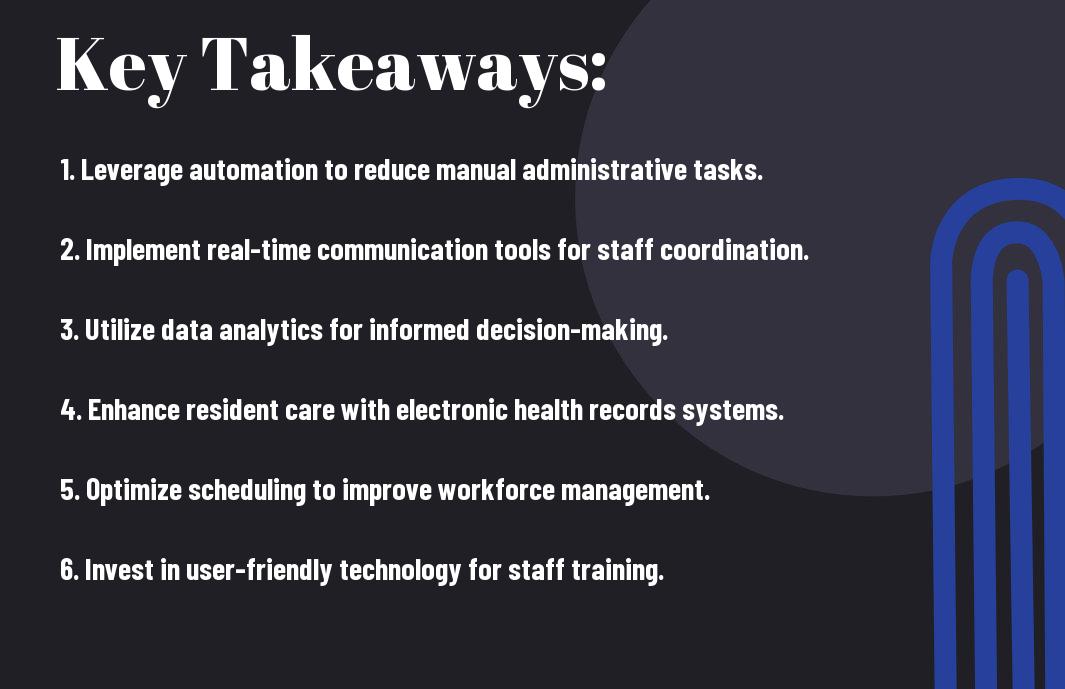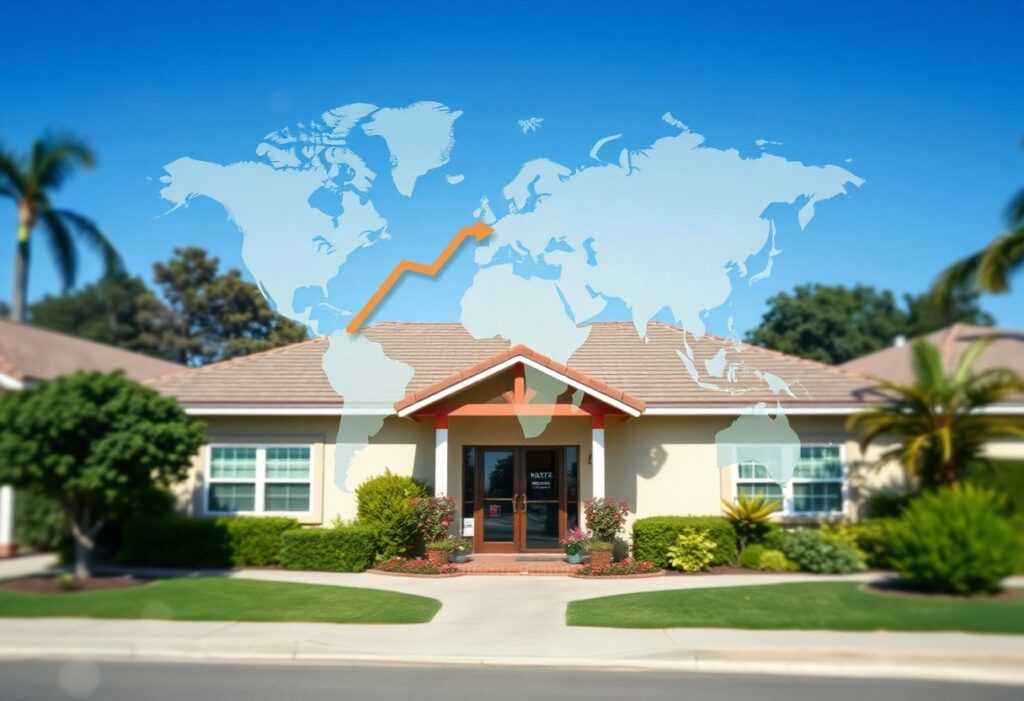You have the responsibility of ensuring that your assisted living facility runs smoothly and efficiently, which can often feel overwhelming. Thankfully, technology solutions can drastically improve operational efficiency in your facility. By implementing the right tools, you can enhance communication, streamline workflows, and ultimately improve residents’ quality of life. In this post, we will explore key technological strategies that can help you optimize your operations, reduce costs, and foster a more productive environment for both staff and residents.

Key Takeaways:
- Integrating technology solutions can significantly reduce administrative burdens, allowing assisted living managers to focus more on resident care and engagement.
- Adopting user-friendly software platforms enhances communication among staff, residents, and families, promoting transparency and better overall service delivery.
- Data analytics tools can provide insights into operational performance, leading to informed decision-making and improved resource allocation within assisted living facilities.
Understanding Operational Efficiency
For assisted living managers, operational efficiency is the ability to maximize resources and minimize waste while delivering quality care. By streamlining processes, you can enhance service delivery, improve resident satisfaction, and optimize your staff’s productivity. This understanding enables you to foster an environment where efficiency leads to better outcomes not just for residents but for your entire facility as well.
Key Performance Indicators in Assisted Living
Behind every successful assisted living facility are key performance indicators (KPIs) that measure the effectiveness of operations. These metrics provide you with valuable insights into resident care, staff performance, and occupancy rates, enabling you to make data-driven decisions. By regularly tracking KPIs, you can identify areas for improvement and ensure that your facility operates at its best.
Challenges Faced by Assisted Living Managers
On your journey as an assisted living manager, you encounter various challenges that can hinder operational efficiency. These challenges range from managing staff shortages and high turnover rates to navigating complex regulatory environments. In addition, balancing financial constraints while ensuring quality resident care demands effective strategies and innovative solutions.
Living in the complex world of assisted living, you often face significant hurdles. Issues like staff shortages can lead to burnout and decreased service quality, creating a ripple effect on resident satisfaction. Moreover, compliance with ever-evolving regulations can feel overwhelming, requiring constant vigilance and adaptation. You also grapple with the daunting task of maintaining a positive work culture amidst financial pressures, making it vital to streamline operations effectively. Addressing these challenges directly impacts your facility’s success, and by leveraging technology solutions, you can provide the quality care your residents deserve while supporting your staff.
Technology Solutions for Streamlining Operations
Some of the most effective technology solutions for assisted living managers involve sophisticated software and systems that can enhance operational efficiency. These tools can help you manage tasks, track residents’ needs, and improve overall communication within your facility, allowing you to focus more on providing exceptional care.
Implementing Electronic Health Records
Beside enhancing data accuracy, implementing electronic health records (EHR) can significantly improve your residents’ care. EHR systems ensure that vital information is easily accessible, which supports informed decision-making and timely interventions, leading to better health outcomes for your residents.
Utilizing Management Software
Streamlining your operations becomes a tangible outcome when you implement specialized management software. This technology helps you oversee various facets of your assisted living facility, such as staff scheduling, medication management, and resident communication. With integrated systems, you can enhance productivity and reduce administrative burdens.
In addition, utilizing management software offers numerous benefits that can positively impact your facility. You’ll be able to automate routine tasks, such as billing and reporting, which saves valuable time. Furthermore, the software enhances communication among staff and residents, fostering transparency. Most importantly, with real-time data analytics, you can proactively address issues, ensuring optimal resource allocation and improved resident satisfaction.
Enhancing Communication Among Staff and Residents
Once again, improving communication within your assisted living facility is vital for fostering a cohesive environment among staff and residents. Utilizing technology can break down communication barriers, enabling smoother exchanges of information and enhancing relationships. By implementing modern communication tools, you’ll enhance engagement, collaboration, and the overall atmosphere of care within your community.
Digital Communication Tools
Digital communication tools, such as messaging apps and dedicated platforms, allow for real-time conversations among staff and residents. These tools ensure that important information is shared quickly and efficiently, enhancing teamwork and improving the residents’ experience. Features like group chats can keep everyone informed and connected, promoting a sense of belonging.
Training and Support for Technology Adoption
Among the barriers to implementing new technologies, training and support play a pivotal role in ensuring that all staff members feel comfortable and confident using these tools. Proper training sessions can alleviate any apprehensions regarding technology, fostering a culture of adaptability and innovation within your facility.
Even with the best tools available, the successful adoption of technology hinges on effective training and continuous support. It’s crucial to tailor your training programs to address the specific needs of your staff. By providing resources and guidance, you empower them to leverage technology effectively, enhancing their communication skills. Building a supportive environment helps mitigate any resistance and promotes a proactive approach to adopting new communication tools, ultimately resulting in better service delivery for your residents.
Data Analytics for Informed Decision Making
All effective operational strategies in assisted living rely on leveraging data analytics. By harnessing the power of data, you can make well-informed decisions that enhance resident satisfaction, streamline processes, and ultimately improve the quality of care. Utilizing technology to interpret the vast amount of data generated in your facilities can provide valuable insights that drive your operational efficiency to new heights.
Collecting and Analyzing Operational Data
The foundation of successful data analytics lies in the systematic collection and analysis of operational data. By systematically gathering information on daily operations, staff performance, and resident feedback, you can build a comprehensive dataset. Using specialized software, you can analyze this information to identify patterns and trends, allowing you to pinpoint areas that require immediate attention or improvement.
Using Insights to Improve Efficiency
Making data-driven decisions is vital for increasing operational efficiency in your assisted living facility. By discerning actionable insights from your operational data, you can optimize workflows, ensure effective resource allocation, and enhance resident engagement. This approach helps you focus on areas where improvements can yield the greatest impact.
Plus, utilizing these insights allows you to enhance your staff’s productivity by aligning their efforts with actual needs. For instance, you may find that specific activities could be streamlined to save time and resources, leading to improved resident care. Additionally, by identifying significant patterns in feedback, you can adapt your services to better fulfill resident expectations. With real-time analytics, you can also proactively address issues before they escalate, ensuring a safer and more satisfying environment for everyone involved.
Cost Management Through Technology
Keep your operational costs in check by leveraging technology solutions designed specifically for assisted living management. By adopting the right software tools and automation systems, you can streamline processes, reduce manual labor, and ultimately lower your expenses. This approach not only enhances efficiency but also allows you to allocate resources where they are most needed, maximizing your budget and improving service delivery.
Reducing Overhead Expenses
Among the most effective ways to decrease overhead expenses is by implementing automated scheduling and billing systems. These tools help you manage staff allocations and track financial transactions seamlessly, minimizing human error and the associated costs. Embracing digital solutions can significantly lower the administrative burden and lead to substantial savings over time.
Maximizing Resource Allocation
Along with reducing overhead, technology also enables you to maximize resource allocation throughout your facility. Efficient management of staff schedules, inventory, and resident care allows you to direct your resources towards areas that need it most. This strategic allocation not only enhances the quality of care you provide but also fosters a more productive environment for both residents and staff.
Considering the impact of technology on resource allocation, you should explore tools that allow for real-time data analytics and reporting. These systems provide you with insight into operational trends and resident needs, enabling you to make informed decisions. By understanding usage patterns, you can effectively adjust staffing levels, optimize inventory, and minimize waste. Ultimately, this leads to a more efficient use of your resources, fostering a positive environment that benefits both residents and your bottom line.

Future Trends in Assisted Living Technology
Despite the rapid evolution in technology, the future of assisted living remains focused on enhancing the quality of care and resident satisfaction. Innovations in AI, IoT, and telehealth are paving the way for improved communication, safety, and efficiency in assisted living facilities, allowing you to stay ahead in managing operational challenges effectively.
Innovations on the Horizon
Innovations are set to transform assisted living environments in significant ways. Advances in robotics, voice-activated systems, and smart home integration will enhance daily living for residents, providing you with tools that foster independence while ensuring safety and support.
Preparing for Technological Advancements
At this point, it’s vital to build your strategy for adopting emerging technologies in assisted living. By staying informed, you can identify the tools that suit your operational needs while enhancing residents’ lives. This proactive approach prepares you to integrate new systems seamlessly.
Understanding the implications of new technological solutions is vital for your success in assisted living. Investing in staff training will empower your team to effectively leverage these innovations, while an emphasis on data privacy ensures that residents’ information remains secure. By embracing collaboration with technology providers, you will not only enhance operational efficiency but also foster an environment that prioritizes resident well-being. Ultimately, your proactive measures in adapting to technological advancements will lead to a more productive and responsive assisted living community.

Conclusion
Following this, you can enhance your operational efficiency as an assisted living manager by implementing technology solutions tailored to your needs. By embracing these advancements, you can streamline processes, improve communication, and optimize resource allocation. For more insights, consider exploring Streamlining Operations in Senior Care Facilities, which offers practical strategies to elevate your management practices. Adopting these technologies will lead to better outcomes for both staff and residents alike.
Q: How can technology solutions improve operational efficiency in assisted living facilities?
A: Technology solutions can automate several administrative tasks, reducing the time staff spends on paperwork and manual processes. This includes electronic health records (EHR) systems that streamline resident information management, scheduling software that optimizes staff assignments, and communication tools that enhance coordination among caregivers. By integrating these technologies, assisted living managers can minimize errors, improve service delivery, and focus more on resident care rather than administrative burdens.
Q: What types of technology can be integrated into assisted living management to enhance resident care?
A: There are various types of technology that can be integrated into assisted living management. Notable examples include telehealth systems that allow for remote health consultations, smart home devices that enhance resident safety and comfort (e.g., fall detection systems), and personalized medication management platforms that help residents adhere to their prescribed regimens. Additionally, data analytics tools can provide insights into resident health trends, allowing staff to proactively address health concerns.
Q: What challenges might assisted living managers face when implementing technology solutions, and how can they be overcome?
A: Managers may face several challenges during the implementation of technology solutions, such as staff resistance to change, inadequate training, and upfront costs. To overcome these challenges, it is imperative to provide comprehensive training programs that empower staff to utilize new technologies effectively. Involving staff in the selection process can also create buy-in and alleviate concerns. Additionally, exploring funding options, grants, or phased implementations can help mitigate financial barriers associated with adopting new technologies.







